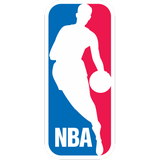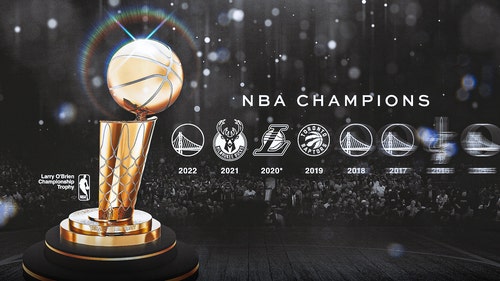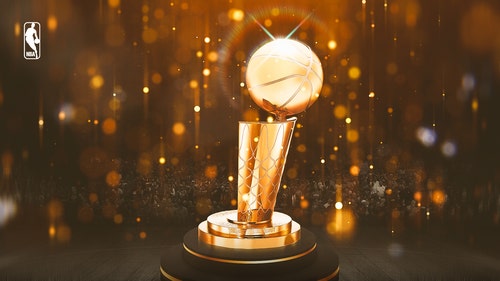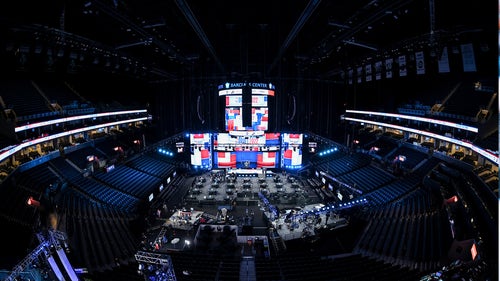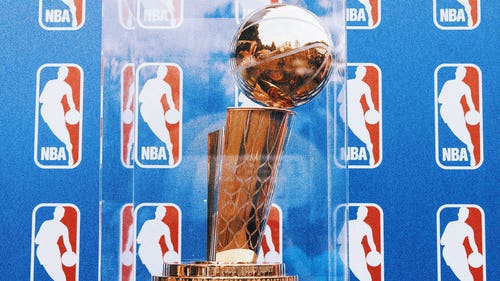
What's behind the explosion of tribute videos by NBA teams?
By Yaron Weitzman
FOX Sports NBA Writer
With 2:38 left in the first quarter, Gary Harris saw his name flash across the Jumbotron hanging from the rafters. He’d been traded by the Nuggets to the Orlando Magic two weeks earlier. This April 2021 night was his first time back in Denver, his home for six-and-a-half seasons.
Harris, looking up from the sideline, watched as the video played. It was stuffed with highlights and memories from his time with the Nuggets. Fast-break dunks. Buzzer-beating 3s. Community Christmas events. A clip of Nuggets coach Mike Malone saying, "He had such a huge impact on us changing the culture here. We all owe Gary Harris a ton of gratitude because of everything he did here on and off the floor."
The video lasted one minute and three seconds. The crowd — limited in attendance due to the pandemic but still loud — rose and applauded. The in-arena camera panned to Harris on the Magic bench. He raised a fist and tapped his heart.
Thirteen minutes later, there was another pause in the action. That’s when a picture of R.J. Hampton flashed across the Jumbotron screen. Hampton had been dealt to Orlando with Harris a couple of weeks earlier. Now the Nuggets were showing highlights of Hampton's time with the team.
Watching it all, Hampton's teammates tried to conceal their laughter. The point guard had spent just four months with Denver. He had appeared in 25 games. He had scored 64 total points.
The video lasted 30 seconds. Afterward, Harris turned to Hampton and said, "I can’t believe they’re giving you one, too."
Hampton, recalling this moment five months later, laughed. "To be honest," he said, "I was also kind of surprised I got one."
In-game video tributes used to be reserved for a select class: former stars returning to a city for the first time, longtime reserves who became fan favorites, members of championship teams.
Such tribute video parameters no longer exist. Accomplishments? No longer required. Memorable moments? Optional. Today, the main criterion appears to be: Did you once wear our team's jersey?
"I’ve had way too many tribute videos," said Robin Lopez, who has played on eight teams in his 14-year NBA career. "Most of them I didn’t even watch."
Lopez is not alone. In 2018, Dwight Howard received a tribute video from the Hawks, despite spending just one season in Atlanta before he was dealt in a cost-cutting move — a trade that, according to ESPN’s Zach Lowe, Hawks players responded to by "screaming with jubilation into their phones." The video featured two dunks, 35 seconds of clips of Howard at local charity events and a mawkish, overwrought soundtrack.
Howard, according to reporters in attendance, didn’t notice the video or even glance up at the screen.
In recent years, such players as Davis Bertans, Corey Brewer, DeMarre Carroll, Robert Covington, Jerami Grant, Taurean Prince, Dario Saric, Tomas Satoransky, Dennis Schroder, Mike Scott and Delon Wright have all received in-game video tributes from former teams. This season alone, we’ve seen Ish Smith, Patrick Beverley, Markieff Morris and Georges Niang receive the same treatment.
"I was pleasantly surprised," Niang said. (His, in case you couldn't remember his former team, came courtesy of the Utah Jazz.)
The earliest example I could find (via a newspapers.com search) of a sports team paying tribute to a former player now active with another team via an in-game video came in August 1987. It was future Hall of Famer Reggie Jackson’s last season playing Major League Baseball, and he was facing the then-California Angels, a former team of his, for the final time. As Jackson strolled to the batter’s box for the first time, the Angels played a video on their in-stadium screen.
"[It] displayed Jackson’s highlights while with the Angels," read the Associated Press game recap. "The display lasted two-and-a-half minutes and drew a standing ovation from the crowd."
As far as I can tell, it took 14 years for an NBA team to follow suit. That came in February 2001, when the New York Knicks welcomed Patrick Ewing, whom they'd traded to the Seattle Supersonics five months earlier, back to Madison Square Garden with a one-minute tribute video.
Five years later, the Sonics displayed one for Nate McMillan, a longtime player and coach for the organization who had left to become the head coach of the Portland Trail Blazers. Two years after that, the Kings gave one to Mike Bibby less than a week after trading him to the Atlanta Hawks.
For the most part, though, NBA teams seemed to reserve in-game video tributes for the deceased: Drazen Petrovic, Dennis Johnson, Red Auerbach.
Then, in 2006, the Miami Heat won their first title. "After that, we started looking for ways to highlight the guys that helped us win it," longtime Heat head coach Erik Spoelstra said. "And I think we were one of the first ones to do videos for former players."
I couldn’t verify that claim, but the Heat did seem to be at the forefront. They were active members of the IDEA (Information Display and Entertainment Association) conference, an annual gathering of stadium display operators from across the world. Around 2007, IDEA added a "best tribute video" category to its annual Golden Matrix Awards. The Houston Astros won the award the first two years. Then in 2011, the Heat became the first NBA team to receive the honor, for a tribute to the retired Alonzo Mourning.
It was around that time that the Heat decided, according to Andy Elisburg, their current general manager and a longtime executive, "that doing a video was the best way to honor the guys from our championship team."
Meanwhile, in-game entertainment was becoming more of a focus across the league.
"We viewed it as essential to create content to help support our brand and to give the fans a quality experience so that what they see in the arena is parallel to what they see at home," said Ed Filomia, the Heat’s senior director of broadcast services and a member of the IDEA Hall of Fame. "We also wanted to empower the crowd so that we could have home-court advantage."
To do so, though, teams needed more content. So they expanded their internal media groups and bolstered their coverage. In-house reporters were hired to conduct friendly interviews. Cameras were sent to practices and charity events.
"We collected so much player content," said one team’s creative director, who, like others interviewed for this story, wasn’t authorized to speak on the record. "So when former players came back, it was an easy way to fill some time in the arena."
Still, when it came to tribute videos, most teams imposed some limits. The Heat, for example, have produced them only for players who were part of a championship team (though Elisburg said no "hard, fast rule" exists). The Knicks, according to a former event presentation executive, "were extremely strict with their choices. They’d say things like, ‘You’re only a legend if your name is in the rafters.'" Other organizations, such as the Thunder, who in 2017 did not do a video for Kevin Durant upon his first return to Oklahoma City, instituted their own restrictions.
This, like so much else in the NBA, has evolved with the rise of player empowerment. With players switching uniforms more than ever, teams today have grown more conscious of how they’re perceived by players around the league. Brand management has become an essential part of team building.
"It’s something that our front office wants us to do for anyone who’s spent a good amount of time with us," one team’s media relations director said. "You never know when you might try to bring a player back, so we’re always trying to have good relationships with all the players who’ve come through."
Matt Tape spent more than a decade overseeing in-arena production for the Houston Rockets, who were at the forefront of this trend. They started doing tribute videos around 2010. The directive, according to Tape, came from general manager Daryl Morey and former president of business operations Tad Brown.
"Everything stemmed from the idea of trying to show that we’re player-friendly," Tape said.
The Rockets took this to the extreme. They presented Carl Landry with a tribute video in 2010. Chuck Hayes received one in 2012 — and again in 2015! Trevor Ariza received one in 2018. Russell Westbrook received one in 2020 after just one season with the Rockets. Chandler Parsons received one in 2014, just a few months after describing the city of Houston as "kind of dirty."
"We were doing so many of them that one of our head coaches once complained to the front office," Tape said. "He was like, ‘Man, we’re trying to win a basketball game. You can’t have fans getting sidetracked and cheering for the other team.’ So we had to dial it back for a bit."
(Tape declined to name the head coach. Attempts to reach Kevin McHale were unsuccessful.)
Today, most tribute video decisions are made following the release of the NBA schedule. Marketing and game operations teams review the calendar and circle the dates featuring former players. When weighing whether to do a tribute video, how players behaved off the court is also taken into account. Were they helpful with community events? Were they courteous with the team’s non-basketball departments? Then, if there’s a questionable name, it’s typically passed to the public relations department, which brings it to the basketball executives, who make the final call.
The pandemic only accelerated this trend. "There was a lot of talk about how with the arenas empty, it was important to remember that the players were our main audience," one team’s creative director said.
And the players noticed. "The videos on the scoreboard definitely seemed to be more directed to us," Lopez said.
The question, of course, is does any of this matter? Are teams right to think that players care about tribute videos or judge an organization based on what it plays on the Jumbotron?
"I think players notice when teams do it," veteran guard Danny Green said. "And I think it’s dope. If you had a very impactful time with that group and that community and that city and everybody loves you, then why not?"
Heat forward P.J. Tucker disagrees. "I can see teams thinking that," he said. "But it doesn’t make a lot of sense for me." Tucker has played for five teams in his 11-year NBA career but has received only one tribute video. It was from the Rockets, whom he helped win four playoff series across three seasons.
"We won a lot of games. We did something," Tucker said. "[But] you shouldn’t get it just because you were on a team for two years. It’s like nothing is there. I wouldn’t even want that."
Yaron Weitzman is an NBA writer for FOX Sports and the author of "Tanking to the Top: The Philadelphia 76ers and the Most Audacious Process in the History of Professional Sports." Follow him on Twitter @YaronWeitzman.
